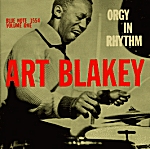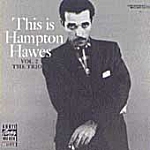|
Ballad of a Thin Man | |
 | There's a great scene in Preminger's 1955 addiction epic, The Man With the Golden Arm, where Shorty Rogers and his Giants are in the studio rehearsing. Rogers is enjoying himself, urbane and goatee-bearded, until the embattled Sinatra turns up, and attempts to prove his mettle as a drummer, looking for the break which will launch him from the gutter. Our hero is suffering from heroin withdrawal, however, so fails to pass muster, and as he leaves, starry-eyed and twitching in disbelief, the great Shelly Manne steps behind the drums and shows him how it's done. Powerfully and effectively done, it shows off the distance between this kind of filmmaking and most of what went on at the time-Sinatra at his skinniest, washed out and washed up, stuttering at the snare, like Bunny Berigan's legendary expression of alcoholic impotence, the 1930's trumpet frenzy of 'I Can't Get Started'. It reminds me that Shelly's output had its darker side, as well as of his penchant for singing - now drummer vocalists are pretty thin on the ground, and ones whose singing matches the explosiveness of their percussive efforts are rarer still, Nina Canal for Ut, Palmolive for The Slits, Sabu Martinez providing the bongo and primitive African chants alongside Art Blakey's own forceful vocal contribution on the alternately brooding and singularly kinetic spaces of Blakey's Orgy in Rhythm sessions. I wouldn't make great claims for Mr. Manne's vocalizing, but there it is, revealed, or exposed, on the Deep People LP - playing alongside the forces of Conte Candoli's incisive trumpet, Bob Cooper's delicate wreaths of baritone sax, Joe Mondragon's (the name alone conjures some valiant St. George figure equipped with his stringed instrument as sole weapon) bass, Bill Russo's gloriously melancholic trombone on 'Ennui' and 'Vignette'. Early 50's playing, straightahead and unpretentious, with enough loose-limbed invention to justify the excursions in to the deeper waters alluded to in the title, but sprung along by the necessity to keep things moving. Three minute shots of invention, in which small- and large-sized combos provide powerful snatches of urban malevolence ('Gloomy Sunday'), buoyed by the mandate to keep seeking fresh possibilities- as Shelly sings, 'it don't mean a thing (if it ain't got that swing).' Now drummerless sessions could appear to be an academic exercise, how better to emasculate the primitive stirrings of a jazz rhythm section by turning the affair into a byword for carefully textured, but anodyne, composition. Not necessarily so- finding an early Jim Hall session for Pacific, it struck me that guitar, piano and bass can fill in where the brushes and sticks seem to have pride of place, as he would spend a career demonstrating, with the likes of the Jimmy Giuffre 3 or Bill Evans. The cover of his Jazz Guitar LP is also a stunning example of what can be achieved with a few simple ingredients, Jim all smiles in front of a tableau being painted before our eyes, paint casually thrown onto a canvas, music and action, motion and emotion in black outline, the figure depicted seemingly that of Hall, but an elastic collection of limbs flurrying, enigmatic and incomplete. This perpetual motion informs a track like '9:20 Special'- a particularly effective instance of this, building from the majestic bass-line of Red Mitchell, the momentum all there as Hall's generous guitar licks keep the train running on time. Or the more reflective 'Deep in a Dream', a gorgeous still centre of interaction feeding the oneiric tempo, the mood fanned along by the laconic haze of guitar and bass meshing in mesmeric fashion. |
 | The masterly bass of Red Mitchell features on another mighty set of trio recordings from the 50's, This is Hampton Hawes. Again a sociological investigation of the jazz archetype on the 50's West Coast would earmark Hawes for prominence, wiry frame, dressed with almost dandyish aplomb, carefully presented suit, moustache tastefully maintained, the epitome of elegance, the cigarette held with easeful abandon as he pierces the viewer with his stare. This is music which leaps out at the listener, the fearless pursuit of dexterity, the steely logic of each solo building into a freeze-frame of late-night spontaneity which emerges intact. It's uncanny how music like this remains imbued with freshness, time after time you can return to the scene of his version of 'Round Midnight' or the serene sparkle of his version of Ellington's 'Just Squeeze Me', each turn of phrase suggesting nothing more than the bright discovery at each restatement of a theme of its enduring charge of sophistication and wit. Hawes's autobiography is, apparently, another classic of the genre- titled Raise Up Off Me, it doesn't figure in the supposedly copyright UL in Cambridge. I can imagine the kind of adventures he recounts, living high, living fast, time in jail, time out of favour, with the likes of Charles Mingus, right up to one of his final sessions, Pepper's Living Legend of 1976 with Charlie Haden and Manne again. |
 | Another seemingly arbitrary combination which could be exploited for devastating effect is that of a two-trumpet line-up, not often essayed in a small group, but observe the subtlety and excitement of the interplay between Fats Navarro and Howard McGhee. Witness the sheer passion of the headlong rush for bebop freedom, two trumpets double-talking, splitting the emphasis, taking cues from each other and easing the manoeuvres, risking everything in flight, but a tightrope of mutual understanding there to protect them. The McGhee-Navarro Boptet formed a potent recipe for pile-driving rhythms, and I'm equally fascinated by the animal metaphors in Navarro's titles. Take 'The Squirrel' or 'The Skunk', marking him out for Kafkaesque undertones, tortured attempts at freedom from the physical boundaries of being Fats, the torment of the nickname 'Fat Girl' which followed him everywhere, present even when playing alongside a group of his named the Thin Men. It's clear that somebody up there didn't like Navarro. As with the great Bud Powell, with whom he played in the Bud Powell's Modernists group of the late-40's, there is a painful documentation in his music of something other inside struggling to emerge- just as with Kafka himself, a Thin Man whose skeletal cartoon figures at once betray a fascination with curvaceous bodies, fullness of movement rather than the contemptuous limits imposed by his pencil-thin frame. What ensures the lasting impact of this kind of driven exploration of spontaneity is the way such music charts a quest for metamorphosis which would remain permanently thwarted off-stage © Marino Guida 1999. |